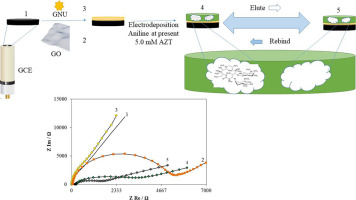当前位置:
X-MOL 学术
›
J. Electroanal. Chem.
›
论文详情
Our official English website, www.x-mol.net, welcomes your
feedback! (Note: you will need to create a separate account there.)
An azithromycin electrochemical sensor based on an aniline MIP film electropolymerized on a gold nano urchins/graphene oxide modified glassy carbon electrode
Journal of Electroanalytical Chemistry ( IF 4.1 ) Pub Date : 2018-11-01 , DOI: 10.1016/j.jelechem.2018.09.053 Saied Jafari , Mohammad Dehghani , Navid Nasirizadeh , Mostafa Azimzadeh
Journal of Electroanalytical Chemistry ( IF 4.1 ) Pub Date : 2018-11-01 , DOI: 10.1016/j.jelechem.2018.09.053 Saied Jafari , Mohammad Dehghani , Navid Nasirizadeh , Mostafa Azimzadeh

|
Abstract In this study, a selective and sensitive procedure was developed based on a molecular imprinted polymer to detect and determine Azithromycin (AZT) antibiotic. AZT-aniline MIP films were electropolymerized (to form polyaniline) on the surface of gold nanourchin/graphene oxide modified glassy carbon electrodes (GNU/GO/GCE), with aniline serving as a monomer and AZT as a template. The morphological and analytical properties of the fabricated nanosensor were characterized by field emission scanning electron microscopy, cyclic voltammetry and electrochemical impedance spectroscopy. The selectivity, linear range, limit of detection, sensitivity and repeatability of the proposed procedure were also evaluated. The analytical performance of the presented sensor that was assessed through differential pulse voltammetry proved to be in the linear range of 0.3 nM to 920.0 nM with the detection of limit 0.1 nM for AZT. In addition, the average current and precision in terms of the relative standard deviation for eight repetitive measurements in 60.0 nM AZT were found to be 0.293 ± 0.07 μA and 2.5% respectively. The proposed sensor was successfully applied for the detection of AZT in human serum.
中文翻译:

基于苯胺MIP膜的阿奇霉素电化学传感器在金纳米海胆/氧化石墨烯修饰的玻碳电极上电聚合
摘要 在本研究中,基于分子印迹聚合物开发了一种选择性和灵敏的方法来检测和测定阿奇霉素 (AZT) 抗生素。AZT-苯胺MIP 膜在金纳米胆/氧化石墨烯修饰的玻璃碳电极(GNU/GO/GCE)的表面上电聚合(形成聚苯胺),苯胺作为单体,AZT 作为模板。通过场发射扫描电子显微镜、循环伏安法和电化学阻抗谱对制备的纳米传感器的形态和分析特性进行了表征。还评估了所提出程序的选择性、线性范围、检测限、灵敏度和可重复性。通过差分脉冲伏安法评估的所提出传感器的分析性能证明在 0.3 nM 到 920.0 nM 的线性范围内, AZT 的检测极限为 0.1 nM。此外,在 60.0 nM AZT 中进行八次重复测量的相对标准偏差的平均电流和精度分别为 0.293 ± 0.07 μA 和 2.5%。所提出的传感器已成功应用于检测人血清中的 AZT。
更新日期:2018-11-01
中文翻译:

基于苯胺MIP膜的阿奇霉素电化学传感器在金纳米海胆/氧化石墨烯修饰的玻碳电极上电聚合
摘要 在本研究中,基于分子印迹聚合物开发了一种选择性和灵敏的方法来检测和测定阿奇霉素 (AZT) 抗生素。AZT-苯胺MIP 膜在金纳米胆/氧化石墨烯修饰的玻璃碳电极(GNU/GO/GCE)的表面上电聚合(形成聚苯胺),苯胺作为单体,AZT 作为模板。通过场发射扫描电子显微镜、循环伏安法和电化学阻抗谱对制备的纳米传感器的形态和分析特性进行了表征。还评估了所提出程序的选择性、线性范围、检测限、灵敏度和可重复性。通过差分脉冲伏安法评估的所提出传感器的分析性能证明在 0.3 nM 到 920.0 nM 的线性范围内, AZT 的检测极限为 0.1 nM。此外,在 60.0 nM AZT 中进行八次重复测量的相对标准偏差的平均电流和精度分别为 0.293 ± 0.07 μA 和 2.5%。所提出的传感器已成功应用于检测人血清中的 AZT。































 京公网安备 11010802027423号
京公网安备 11010802027423号